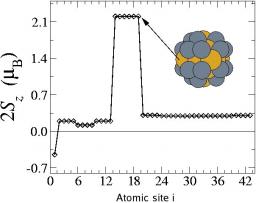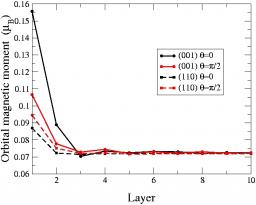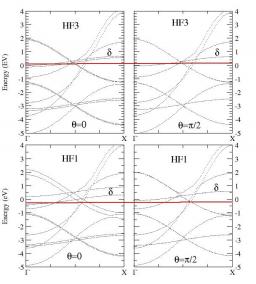2007
FeNi alloys are widely used magnetic materials. Surprisingly experiments have shown that the magnetic moment per atom in FeNi clusters is much lower than that of the bulk alloy of the same composition [1]. Using a Stoner-like tight-binding model, including spin-orbit coupling, we have calculated the magnetic properties of fcc FexNi1-x clusters (x<0.6) containing up to about 300 atoms for several compositions and three types of chemical order: random and core-shell structures with either Ni or Fe cores [2]. The results show that only the latter type of order is compatible with the observed reduction of moment which can be explained by the existence of an anti-ferromagnetic order in the fcc Fe core (Fig.1)
The magnetic properties (spin and orbital magnetic moments, magneto-crystalline anisotropy energy (MAE)) of nanoparticles, thin films and wires have recently attracted a lot of attention due to their potential applications mainly in the Information Technology sector.
We have carried out a systematic study of the magnetic properties of iron in the tight-binding approximation including s, p, and d valence atomic orbitals taking into account spin polarisation using a Stoner-like model and in the presence of spin-orbit coupling[1]. The validity of the model has first been established by studying in details the magnetic properties of the bcc and fcc bulk phases and comparing the results to those of ab-initio calculations using the PWscf code. This model has then been applied to investigate the (110) and (001) bcc surfaces. The corresponding electronic structures and magnetic moments are very similar to those obtained from ab-initio codes. In addition we have studied the variation of the component of the orbital magnetic moment on the spin quantisation axis as a function of depth, revealing a significant enhancement in the first two layers, especially for the (001) surface (see Fig.1).
Spin electronics is an emerging science which aims at using the spin of the conduction electrons in electronic devices. In a near future, the fundamental mechanisms of spin transport will be affected by some physical limits linked to a further size reduction towards the nanometer scale. It is thus fundamental to understand these limits and more generally the physics of magnetism and transport in reduced dimensions.
Metal-metal nanocontacts are crucial in many areas, but have been poorly investigated from the point of view of local magnetism. This is a very appealing research domain, since local magnetism will greatly influence the (ballistic) conductance across a nanocontact. The break junction technique is a tool that allows the creation of stable (several hours) atomic contacts, which consists in breaking a material in a controlled manner by bending it until eventually a single atom contact appears between the two surfaces. Once a stable configuration is obtained the resistance can be measured as a function of an applied magnetic field. Michel Viret (CEA, SPEC) showed that in magnetic materials such as Fe, Co or Ni, one can obtain large magneto-resistive effects [1].













